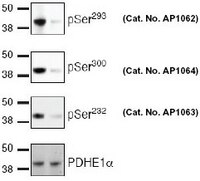AP1064 Sigma-AldrichPhosphoDetect™ Anti-PDH-E1α (pSer³⁰⁰) Rabbit pAb
This PhosphoDetect™ Anti-PDH-E1α (pSer³⁰⁰) Rabbit pAb is validated for use in Immunoblotting, Immunocytochemistry for the detection of PDH-E1α (pSer³⁰⁰).
More>> This PhosphoDetect™ Anti-PDH-E1α (pSer³⁰⁰) Rabbit pAb is validated for use in Immunoblotting, Immunocytochemistry for the detection of PDH-E1α (pSer³⁰⁰). Less<<同義語: Anti-Pyruvate Dehydogenase pSer³⁰⁰ Rabbit pAb
お勧めの製品
概要
| Replacement Information |
|---|
主要スペック表
| Species Reactivity | Host | Antibody Type |
|---|---|---|
| H | Rb | Polyclonal Antibody |
価格&在庫状況
| カタログ番号 | 在庫状況 | 包装 | Qty/Pk | 価格 | 数量 | |
|---|---|---|---|---|---|---|
| AP1064-50UGCN |
|
樹脂アンプル | 50 μg |
|
— |
| Product Information | |
|---|---|
| Form | Liquid |
| Formulation | In 150 mM NaCl, 100 mM Tris-Glycine, pH 7.4. |
| Negative control | HEK293 cells treated with dichloroacetate |
| Positive control | HEK293 cells |
| Preservative | ≤0.1% sodium azide |
| Quality Level | MQ200 |
| Physicochemical Information |
|---|
| Dimensions |
|---|
| Materials Information |
|---|
| Toxicological Information |
|---|
| Safety Information according to GHS |
|---|
| Safety Information |
|---|
| Product Usage Statements |
|---|
| Packaging Information |
|---|
| Transport Information |
|---|
| Supplemental Information |
|---|
| Specifications |
|---|
| Global Trade Item Number | |
|---|---|
| カタログ番号 | GTIN |
| AP1064-50UGCN | 04055977227802 |
Documentation
PhosphoDetect™ Anti-PDH-E1α (pSer³⁰⁰) Rabbit pAb (M)SDS
| タイトル |
|---|
PhosphoDetect™ Anti-PDH-E1α (pSer³⁰⁰) Rabbit pAb 試験成績書(CoA)
| タイトル | ロット番号 |
|---|---|
| AP1064 |
参考資料
| 参考資料の概要 |
|---|
| Rardin M.J., et. al. 2009. Anal. Biochem. 2, 157. Seifert, F., et al. 2007. Biochemistry 21, 6277. Lee, J., et al. 2007. Mol. Cell Prot. 4, 669. Patel, M.S. and Korotchkina, L.G. 2006 Biochem. Soc. Trans. 34, 217. Korotchkina, L.G., et al. 2001. J. Biol. Chem. 40, 37223. |









